OUR ENVIRONMENT for Class 10 BIOLOGY
INTRODUCTION
- We can define the environment as a sum total of all the living and nonliving elements and their effects on human life. In this chapter, we will be studying how various factors in the environment interact with each other and how we impact the environment. In Class IX, we saw how different materials are cycled in the environment in separate biogeochemical cycles. In these cycles, essential nutrients like nitrogen, carbon, oxygen and water are changed from one form to another. Now we will see how human activities affect these cycles.
EFFECTS OF WASTE ON THE ENVIRONMENT
- Hum apni daily life me bahut zyada amount me waste produce karte hain jiske environment par harmful effects ho sakte hain.
- Generally, waste 2 types ka hota hai : ya toh Biodegradable ya Nonbiodegradable.
- Biodegradable wo jisko microorganism simpler molecules me breakdown sake jinko fir baki plants as nutrients use kr lete hain toh ek tareeke se zero waste produce hua jo environment ko harm nahi karta.
- Nonbiodegradable aisa waste hota hai jisko microorganisms simpler molecules me break na kar sakey toh ye waste jis environment me hota hai uss environment ko pollute karke vha jitni bhi life forms hai unki life ko khatre me daalta hai jaisey ki plastic waste. Plastic agar water forms me present hai toh vhaan ki aquatic life ke liye khatra hai jaise ki agar galti se tortoise ya fish vgarah ne isko ingest kiya toh unko death ho sakti hai, similarly agar land pe hai toh yeah land pollution cause karta hai.
EFFECTS OF WASTE ON THE ENVIRONMENT
- In our daily activities, we generate a lot of material that are thrown away.
- Substances that are broken down by biological processes are said to be biodegradable like food, kitchen waste (vegetable peels and food leftovers).
- Substances that are not broken down in this manner are said to be non-biodegradable. These substances may be inert (non reactive) and simply persist in the environment for a long time or may harm the various members of the ecosystem like plastics are non biodegradable.
- Effect of biodegradable wastes :
1.) Biodegradable substances are decomposed by the action of microorganisms and decomposed materials are recycled through a geo-chemical cycle.
2.) These substances keep the environment clean. - Effect of non-biodegradable wastes :
1.) They cause air, water and soil pollution.
2.) They may cause biomagnification in the food chain and end up in humans.
ECOSYSTEM AND ITS COMPONENTS
- Ek area me jitni bhi life forms (biotic component) ek sath rehti hai wo uss jagah ke non living forms (abiotic component) ke sath interact karke ek ecosystem banate hain toh ecosystem ko we can define by : interaction of living and nonliving components in an geographical area.
- Har ecosystem ke 2 components hote hai :
Living / Biotic components : plants, animals etc. and
Abiotic / Non-living components : like air, sand etc. - Ecosystem nature me apne aap bnte hai jaisey ki desert ecosystem ya forest ecosystem but man made yani ki artificial ecosystems aise ecosystem hote hai jinko hum banate hai, like a garden, park, crop fields etc.
- Har ecosystem me 3 basic life forms hoti hai : apna khana khud bnane wale : producers, consumers : jo producers par feed karte hain and decomposers jo sab dead and decaying organic matter ko wapis se simpler molecules me todte hai jisko new plants vgrah firse apne nutrition ki tarah use kr letey hai toh yeah aisi cycle chalti rehti hai.
- Producers apna khana sunlight ki help se bnate hai. Different producers me different processes hoti hai jaisey ki plants apna khana photosynthesis ki help se bante hai.
- Wo organism jo directly plants par feed kare wo primary consumer kehlate hai jaise ki herbivores.
- Jo herbivores ko khate hai (carnivores) wo secondary consumers kehlate hain jaisey ki lion, tiger etc.
- Omnivores, meat and plant food dono ko kha sakte hain jaise ki human, dog etc.
- Yeah jo humne abhi levels padhe hain jaisey ki sabse pehle producers fir primary and secondary consumers vgarah aatey hai toh in levels ko hum trophic levels kehte hai. Jo jo different organism in various levels par interact karte hai wo ek food chain bnate hain and food chains interconnect hokr ek food web bnati hai.
- Yeah jo uper image hai wo hue different trophic levels batati hai. Sabse pehli level producers (plants) ki hoti hai jinko primary consumers (herbivores) consume karte hain. Primary consumers ko secondary consumers (small carnivores) kahte haina and secondary consumers ko fir tertiary consumers (large carnivores, omnivores) khate hain.
- Sunlight ko capture karke producers ne jitni khana apne liya bnaya, jab inko herbivores khayega toh uss herbivore ko ek plant ki total energy se keval 10% energy milegi ya yeah keh sakte hain ki ek trophic level se dusri trophic level par original ki 10% energy hi jati hai and issey hum 10% energy law kehte hain.
- For example : sunlight ko capture karke plant ne 5000KJ energy store karli, jab iss plant ko herbivore khayega toh uss herbivore ko iss 5000KJ ka keval 10% (yani ki 500KJ) hi milega qunki baki energy heat vgrah ki form me lost ho gyi.
- Energy flow diagram hume yeah btata hai ki energy kis direction me flow karegi.
→ energy hamesha unidirectionally flow karti hai. Yani ki producers se different consumer tak. Kabhi bhi yeah nhi hoga ki consumer se energy wapis producer ki taraf aa jaye.
→ Biological Magnification wo process hai jisme koi contaminant (jaise ki koi heavy metal like mercury ya pesticide ya insecticide) ki concentration har trophic level par increase karti jati hai. - For eg : maanlo plant me humne insecticide spary kiya toh ek plant me uss chemical ki concentration 5ppm hai toh aisey bahut sare plants ko ek herbivore kha jayega toh uss herbivore me iss chemical ki concentration let’s say 50 ppm ho gyi. Ab aisey bahur sarey herbivore ko ek carnivore apne life time me kha jayega toh har herbivore ke sath uss carnivore ki body me uss harmful chemical ki concentration badhti jayegi jo uske liye harmful hogi. Yhi phenomenon biological magnification kehlata hai.
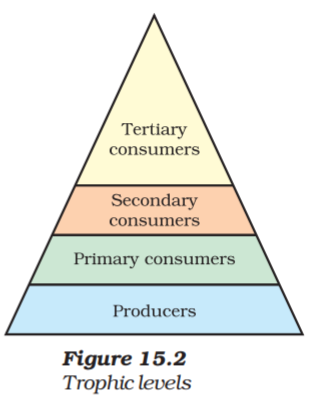
ECOSYSTEM AND ITS COMPONENTS
- All the interacting organisms in an area together with the non-living constituents of the environment form an ecosystem.
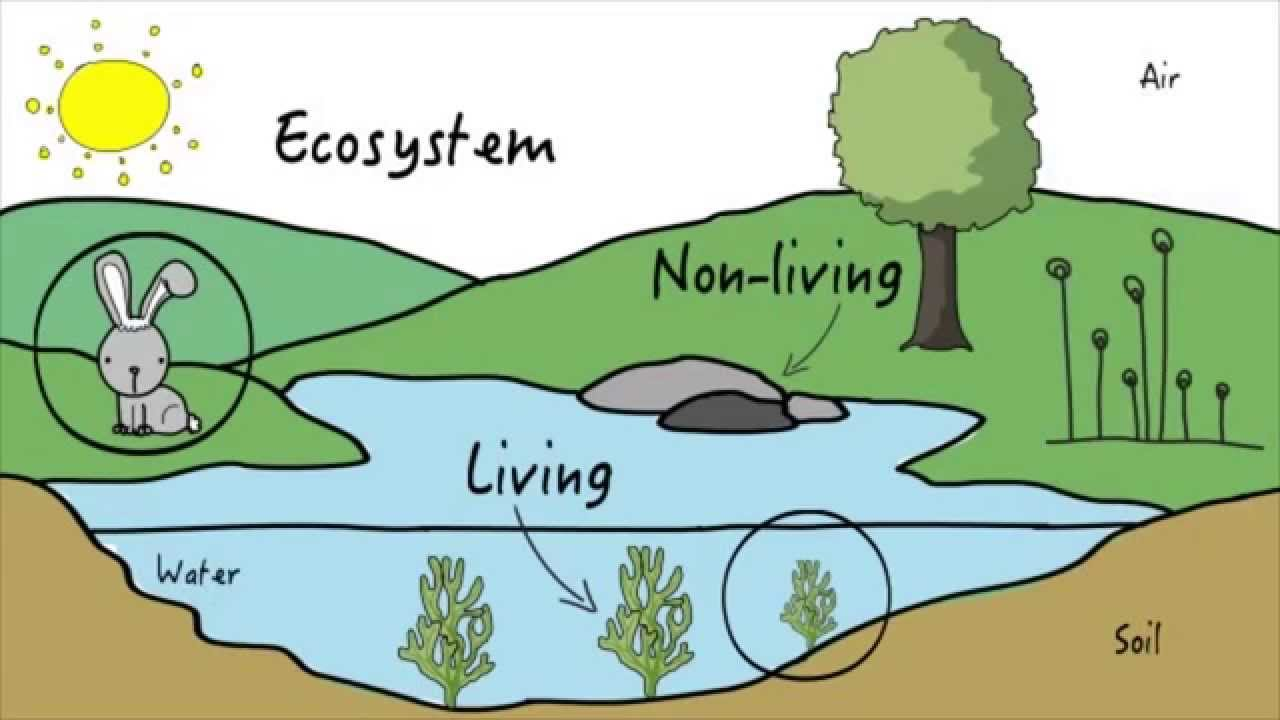
- So, an ecosystem consists of biotic components comprising living organisms (cat, dog, human, plants, insects, microorganisms) and abiotic components comprising physical factors like temperature, rainfall, wind, soil and minerals.
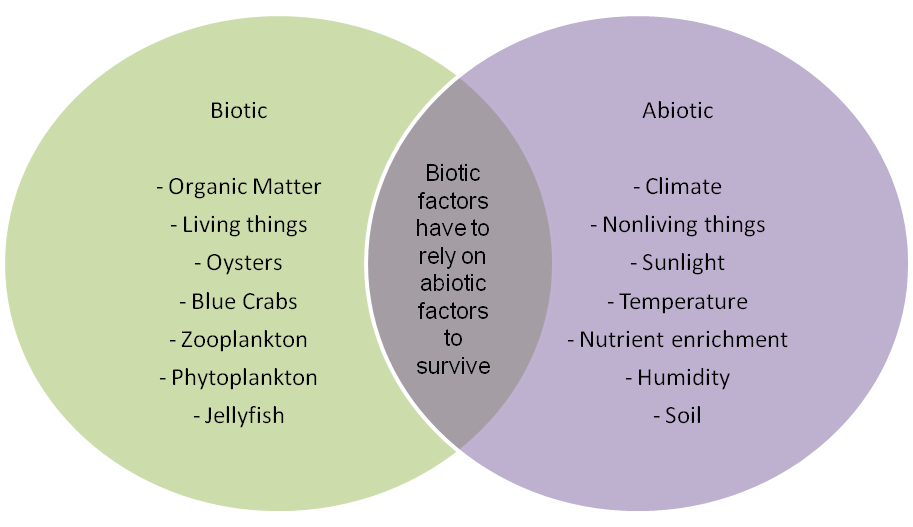
- All these living organisms interact with each other and their growth, reproduction and other activities are affected by the abiotic components of the ecosystem.
- So a garden is an ecosystem.
- Other types of ecosystems are forests, ponds and lakes. These are natural ecosystems while gardens and crop-fields are human made (artificial) ecosystems.
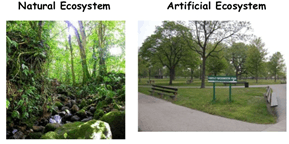
- All green plants and certain blue green algae which can produce food by photosynthesis come under the category called as producers.
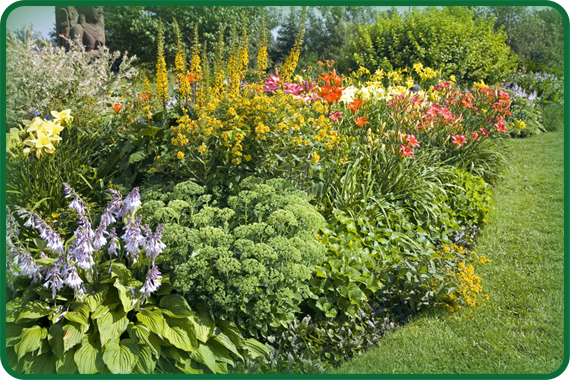
- The organisms which consume the food produced, either directly from producers or indirectly by feeding on other consumers are the consumers.
- Consumers can be classed variously as herbivores (goat, cattle), carnivores (lion, tiger), omnivores (human, dog) and parasites (worms, skin mites, lice).
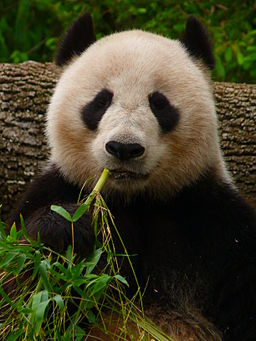
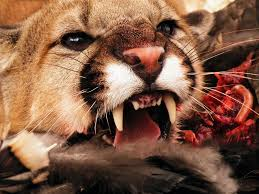
A lice (parasite) is shown below :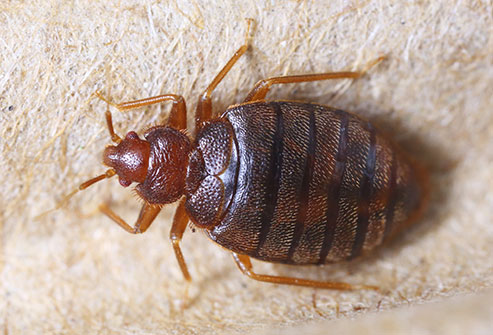
- The microorganisms, comprising bacteria and fungi, break-down the dead remains and waste products of organisms. These microorganisms are the decomposers as they break-down the complex organic substances into simple inorganic substances that go into the soil and are used up once more by the plants.

- The series of organisms taking part at various biotic levels form a food chain.
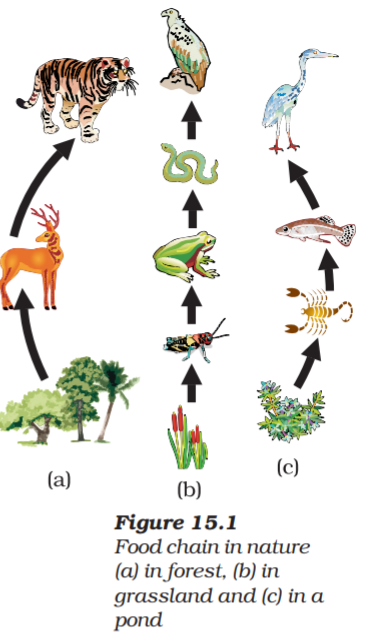
- Each step or level of the food chain forms a trophic level.
- The autotrophs or the producers are at the first trophic level. They use the solar energy and make it available for heterotrophs or the consumers.
- The herbivores or the primary consumers come at the second, small carnivores or the secondary consumers at the third and larger carnivores or the tertiary consumers form the fourth trophic level.

- The autotrophs capture the energy present in sunlight and convert it into chemical energy. This energy supports all the activities of the living world. From autotrophs, the energy goes to the heterotrophs and decomposers but some energy is lost to the environment in forms which cannot be used again.
- The green plants in a terrestrial ecosystem capture about 1% of the energy of sunlight that falls on their leaves and convert it into food energy.
- For a consumer on an average of 10% of the food eaten is turned into its own body and made available for the next level of consumers. This means that only 10% of the energy is transferred from one trophic level to the next. This is known as the 10% law.
- Since so little energy is available for the next level of consumers, food chains generally consist of only three or four steps. The loss of energy at each step is so great that very little usable energy remains after four trophic levels.
- There are generally a greater number of individuals at the lower trophic levels of an ecosystem (because more number of producers are required to satisfy a few consumers), thus the greatest number is of the producers.
- Energy Flow Diagram
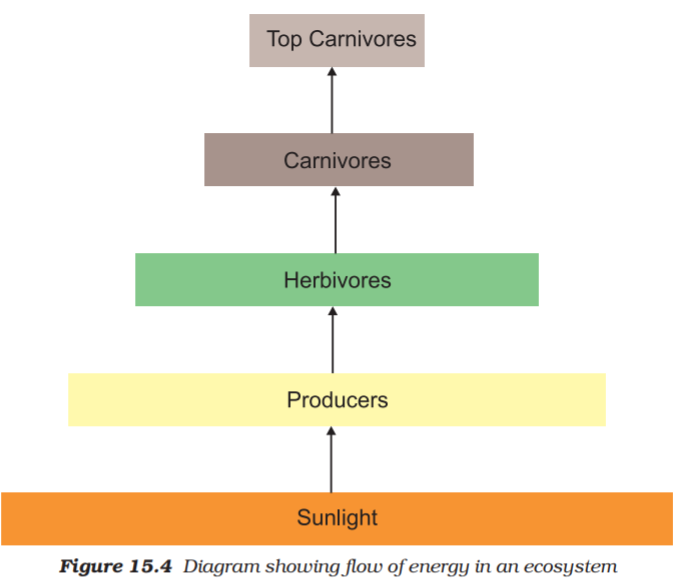
→The flow of energy is unidirectional. The energy that is captured by the autotrophs does not revert back to the solar input and the energy which passes to the herbivores does not come back to autotrophs.
→Biological Magnification : The increase of concentration of harmful chemicals at each trophic level is known as biological magnification.
Food Chains and Webs
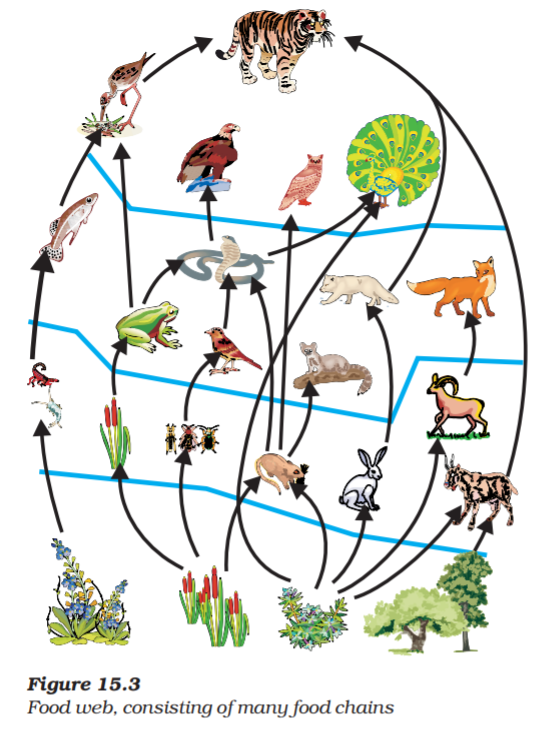
HOW DO OUR ACTIVITIES AFFECT THE ENVIRONMENT?
- Humans ki lagbhag sabhi activities nature ko effect karti hai kisi na kisi way me. Abhi hum 2 cheezein padhenge : ozone depletion (generally isse question puch liya jata hai) and waste management.
- Ozone upper atmosphere me troposphere layer me milti hai. Yeah ek light blue colour ki poisonous gas hai but iska ek bahut hi important role hai troposphere me : wo hai ki yeah layer sun se aana waley UV radiation ko earth ke surface tak aane se rokta hai qnki UV rays har life form ke liye harmful hai : jaisey ki humans me skin cancer, retina related diseases and mutation vgarah ka ek karan UV rays bhi hai.
- 1913 ke aas paas refrigerators ka use shuru hua and 1980s me ozone layer deplete ho gyi yani ki uski thickness decrease ho gayi kyon ki refrigerators me CFCs use hota hai and CFCs ozone layer ko deplete karta hai.
- O2 ke molecules par jab UV rays girti hai toh yeah molecule 2 oxygen atoms (O) me split karta hai jo O2 molecules ke sath milkar ozone ke molecule (O3) ki formation karti hai.
- Waste management ke liye sabse acha hota hai ki hum waste produce hi kam kare.
- Baki 3R’s : reuse, reduce and recycle bhi ek achi strategy hoti hai waste ko manage karne ke liye.
- Jo waste recycle ya reuse nahi ho sakta usko hum closed chambers me jla dete hai jisko incineration kehte hai.
- Biodegradable waste ko hum ek ground me pit khod kr usme dump karke kuch 4-5 mahine ke liye aisey hi chor dete hai jha usko microorganisms degrade karke usko compost me convert kar dete hai jo ki plants ke liye manure ki tarah kaam karta hai. Iss process ko hum composting kehte hain.
HOW DO OUR ACTIVITIES AFFECT THE ENVIRONMENT?
- Changes in the environment affect us and our activities change the environment around us. We know that how our activities pollute the environment, now we will study two of the environmental problems in detail, that is, depletion of the ozone layer and waste disposal.
- Ozone (O3) is a molecule formed by three atoms of oxygen.
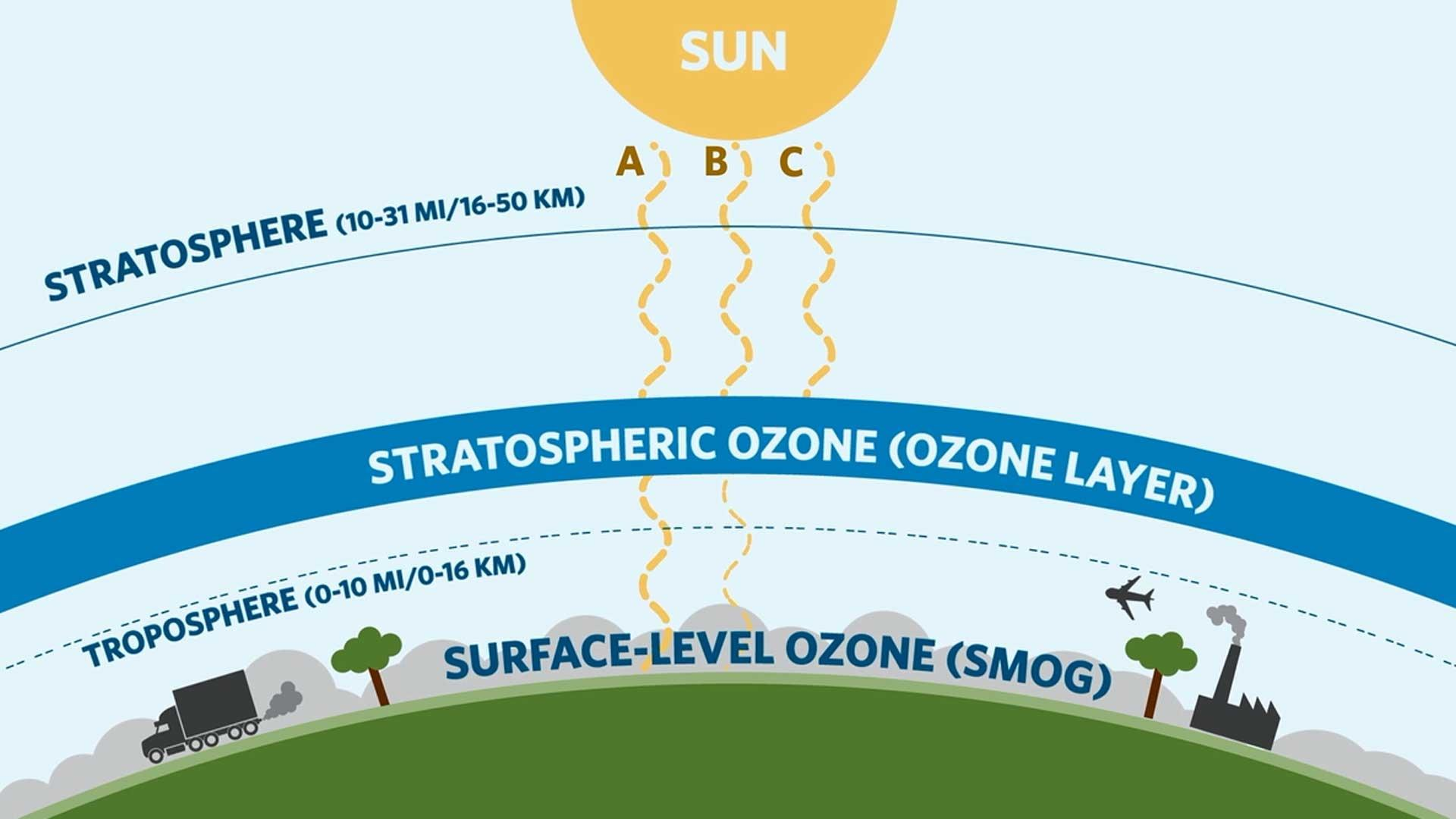
- Ozone is light blue in colour and is a deadly poison.
- At the higher levels of the atmosphere, ozone performs an essential function : It shields the surface of the earth from ultraviolet (UV) radiation from the Sun. The UV radiation is highly damaging to organisms, for example, it is known to cause skin cancer, sunburn, retinal problems etc.etc.
- So ozone forms a shield and prevents UV rays from reaching the earth’s surface.
- Ozone is a product of UV radiation acting on oxygen (O2) molecules.
→ The high energy UV radiations split apart some molecular oxygen (O2) into free oxygen (O) atoms. These atoms then combine with the molecular oxygen to form O3.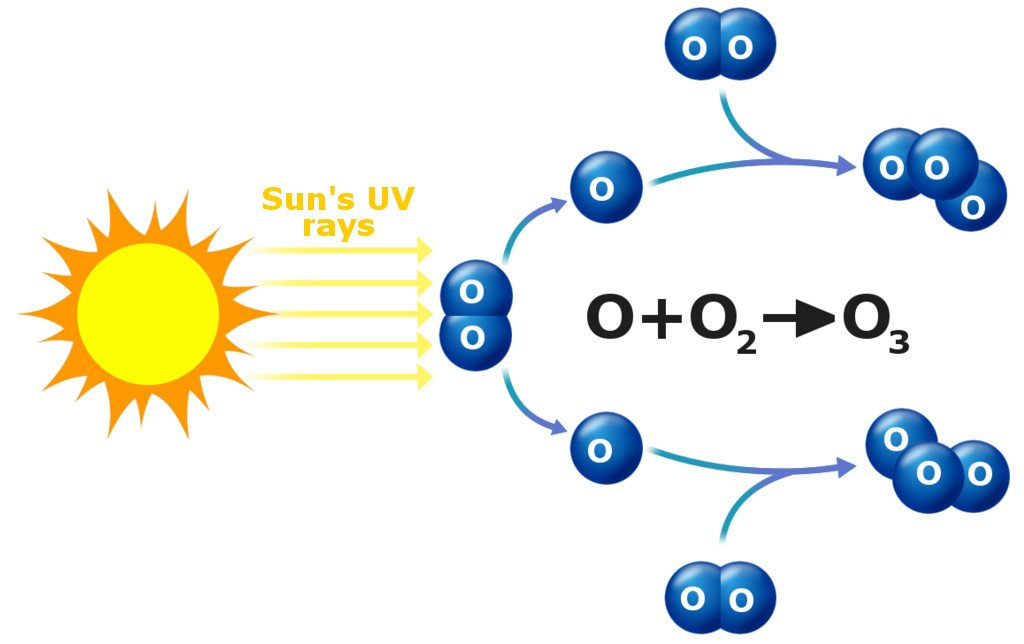
- In the 1980s the amount of ozone in the atmosphere began to drop sharply due the presence of the chemicals like chlorofluorocarbons (CFCs) which are used as refrigerants and in fire extinguishers.

- In 1987, the United Nations Environment Programme (UNEP) succeeded in forging an agreement to freeze CFC production at 1986 levels.
- Improvements in our life-style have resulted in greater amounts of waste material generation.
- Changes in packaging have resulted in much of our waste becoming nonbiodegradable.
- Proper waste management involves the use of garbage as a valuable resource, usually by recycling items that can still be used.
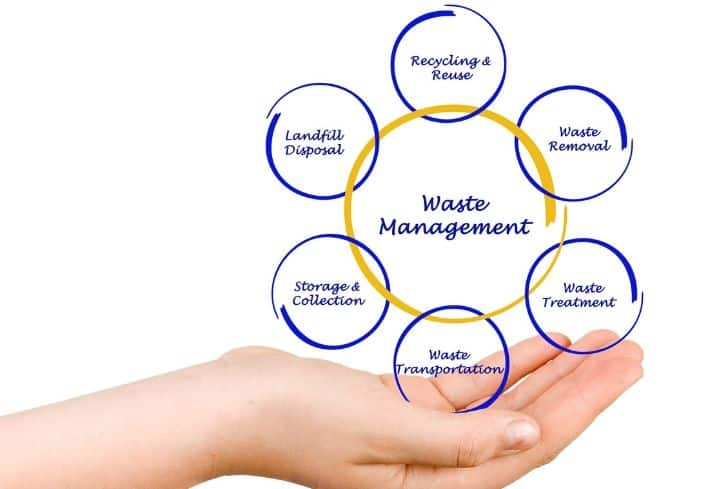
- The 3 R’s (reduce, reuse and recycle) : reduce the waste at source level, reuse whatever can be reused and recycle the left over waste.
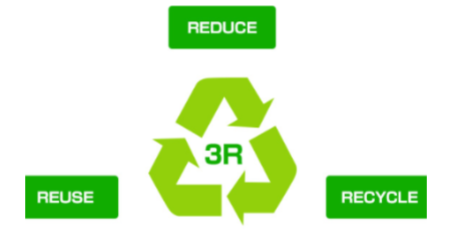
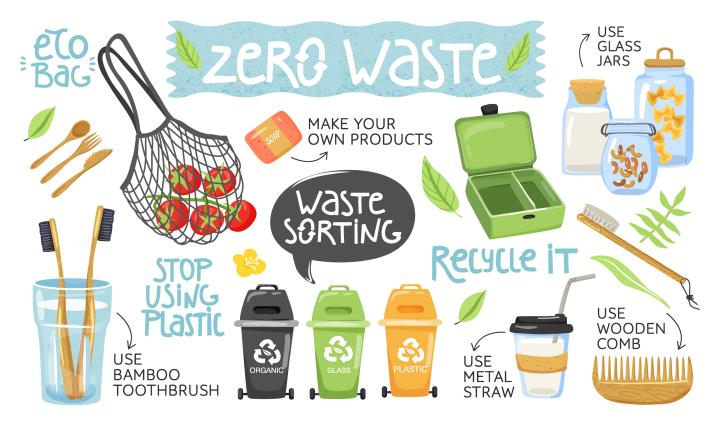
- Incineration : solid wastes that cannot be recycled are burned at high temperatures to reduce its volume by up to 80 percent. This method can also be used to generate heat, gas, and steam for power.
- Composting : is a natural process of degradation of organic wastes (kitchen waste and plant remains) and converting that waste into nutrients for plants. This is a common technique in organic farming, where the organic materials are left in a pit for months to allow for natural decomposition by decomposers .
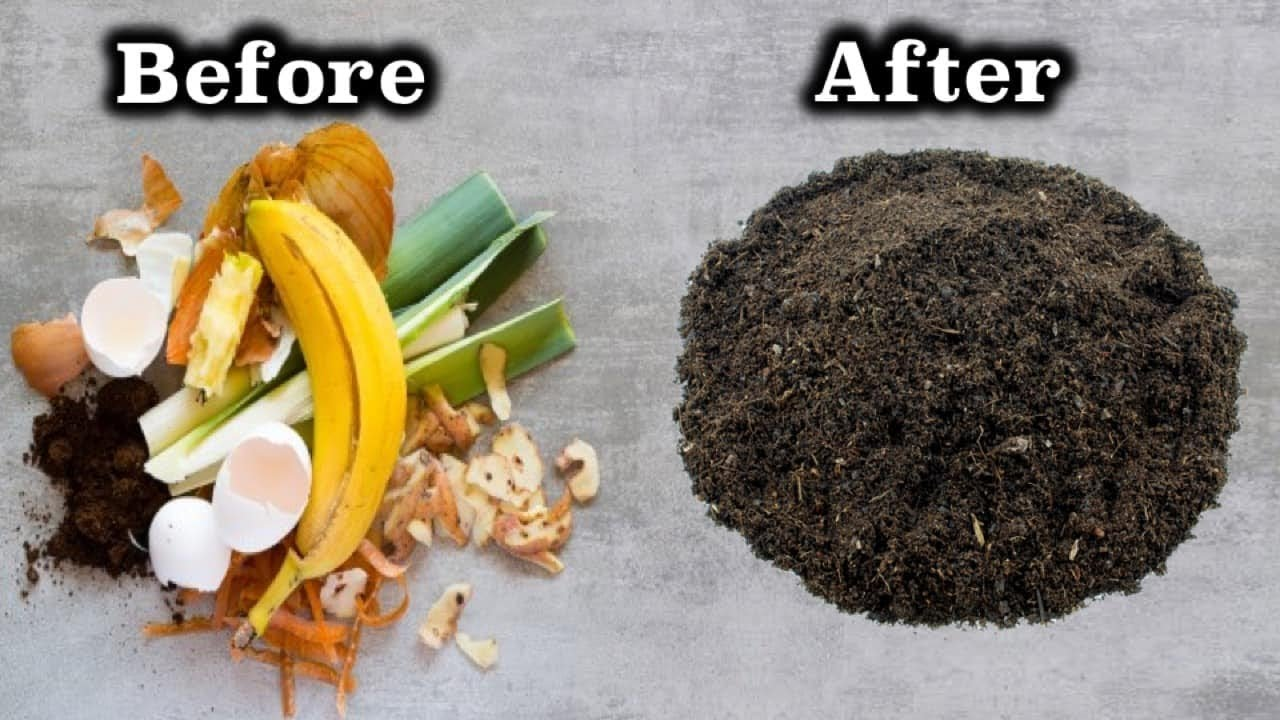
Depletion Of The Ozone Layer
Managing the Garbage we Produce
SUMMARY
- The various components of an ecosystem are interdependent. The producers make the energy from sunlight available to the rest of the ecosystem. There is a loss of energy as we go from one trophic level to the next, this limits the number of trophic levels in a food-chain. Human activities have an impact on the environment. The use of chemicals like CFCs has endangered the ozone layer. Since the ozone layer protects against the ultraviolet radiation from the Sun, this could damage the environment. The waste we generate may be biodegradable or non-biodegradable. The disposal of the waste we generate is causing serious environmental problems.